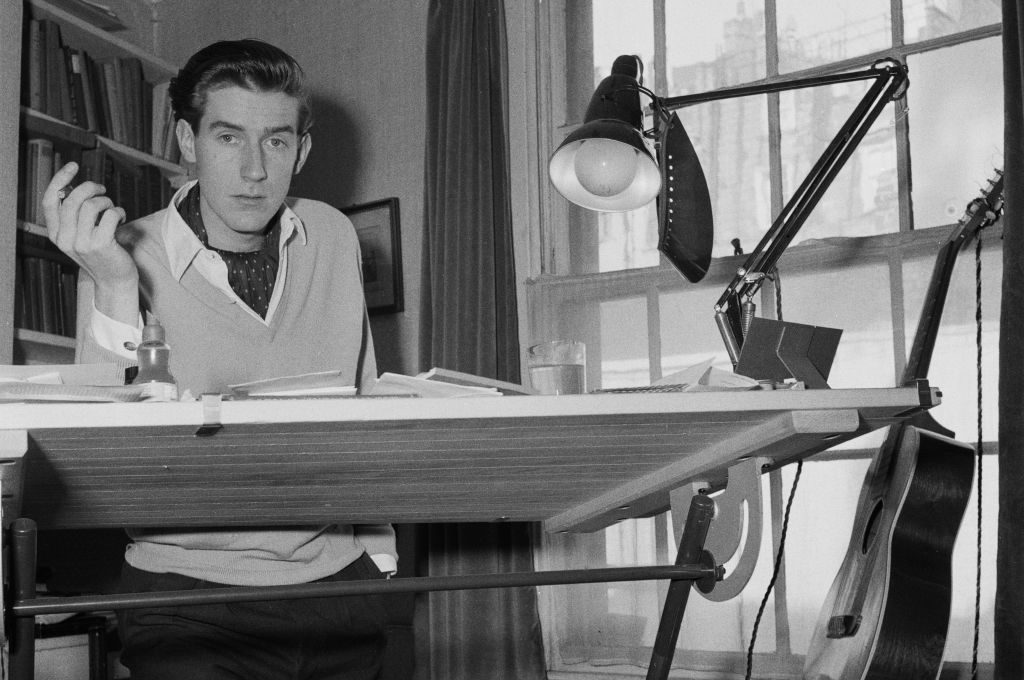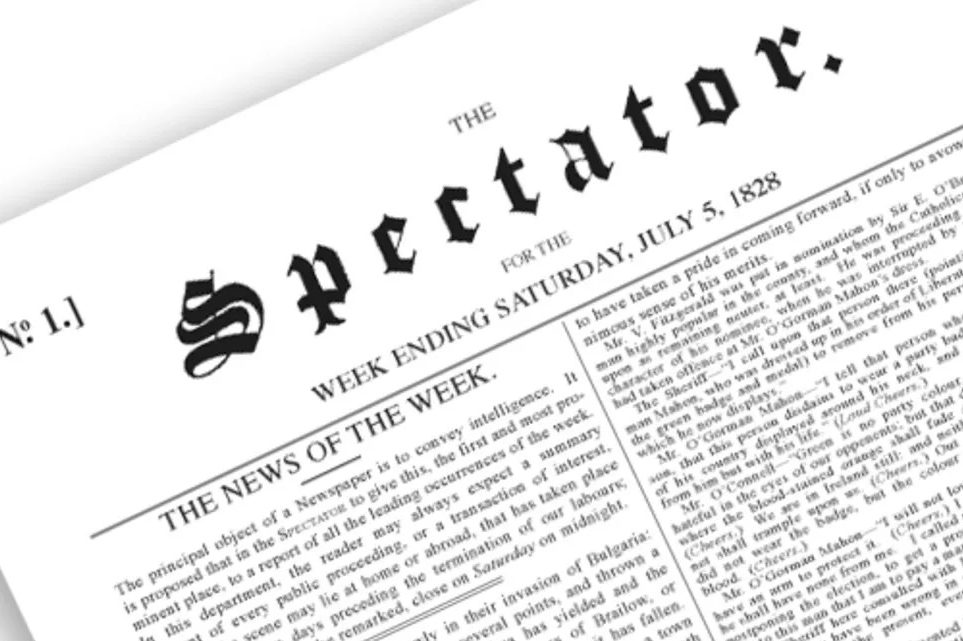The old masters: how well they understood. John Betjeman’s architecture column ran for just over three years in the mid-1950s. Yet during that short run he experienced the moment that comes, sooner or later, to every regular writer in The Spectator’s arts pages. ‘It is maddening the way people corner one and make one discuss politics at the moment,’ he wrote on November 23, 1956, clearly as bored of the Suez crisis as the rest of us were, until recently, by Brexit:
‘Because I write in this paper, people assume that I share its Editor’s views about Suez…but I don’t know what the views of this paper about Suez are, because I never read the political stuff in front. I take The Spectator to see whether there are any misprints in this column and for the book reviews and for dear old Strix and the angry letters. I have always imagined that most readers of periodicals like this and the New Statesman subscribe for literary rather than political reasons, and that the politics are in the nature of topical photographs designed to lighten and heighten the rest.’
He’s right, though, isn’t he? The magazine’s priorities are blazoned on the title page of the second collected volume, in January 1829: A Weekly Journal of News, Politics, Literature and Science. But leaf through the archives and be honest: which would you rather read now? Decade-long discussions of Irish home rule? The progress of the Scotch Promissory Notes bill? Or a really epic takedown of Charles Dickens?
Posterity has a way of winnowing out the good stuff, and The Spectator has spent 10,000 issues identifying the dominant cultural phenomena of the day and being difficult about them. ‘We cannot congratulate ourselves upon the progress of the musical art in London. The same routine of sinfonias by Haydn, Mozart, Beethoven, and Spohr; the same overtures by Cherubini, Weber, and Romberg…are gone through, and the aggregate of taste remains pretty equal,’ begins the first ever arts column on July 5, 1828. And immediately, you feel at home.
The Spectator’s brief, after all, is to spectate — or as Roy Strong put it, visiting Madame Tussauds in 1967, to serve as ‘a new London Spy spicing the eyes with the trifles of a 20th-century Ned Ward’. (Strong was there to analyze the faces of the Swinging Sixties. David Hockney — interviewed in this issue — looked like a ‘supersonic owl’. Mick Jagger resembled ‘a pitted plum on to which have been grafted sensuous lips and wayward eyes’.) In 1928, a centenary retrospective suggested that the magazine had been ‘very quick to recognize solid achievement, a little slower to praise talent that came with disruptive and unusual vigor’. ‘It is not very profitable, then, to read through The Spectator in the hope of finding giant howlers,’ it concluded.
Really? Hold my glass of crusted port, as Richard Holt Hutton, both editor and literary editor from 1861 to 1897, almost certainly never said. The ‘somewhat sordid’ Jane Eyre was frostily reviewed in 1847 (‘neither the heroine nor hero attracts sympathy’), and Verdi’s La Traviata received a pasting in 1856, principally for the heroine’s ‘infamous’ morality. The Spectator was quicker to appreciate the qualities of Turner’s ‘Fighting Temeraire’ in August 1844, though quicker still to denounce ‘those freaks of extravagance that detract from the beauty and obscure the meaning of too many of Turner’s works’. But Dickens is the main exhibit in the hall of shame, and the length and rigor of The Spectator’s famous slating of Bleak House in September 1853 can’t quite dispel an aroma of snobbery:
‘He must be content with the praise of amusing the idle hours of the greatest number of readers; not, we may hope, without improvement to their hearts, but certainly without profoundly affecting their intellects or deeply stirring their emotions.
On the credit side, The Spectator spotted George Eliot early and never stopped cheering her on. Middlemarch was published as a serial, and in October 1872 Hutton declared it ‘one of the great books of the world’ even before the final volumes had appeared. Each installment was devoured and discussed with the impatience of a Succession junkie waiting for season three: ‘We all read it…and not a few of us calculate whether we shall get the August number before we go for our autumn holiday, or whether we shall have to wait for it till we return.’
Then there are the moments when the editor guides a writer to the ideal subject, and creates something remarkable in itself — a glimpse of immortality before any other contemporary could have perceived or expressed it. They’re not always easy to rediscover: until the early 20th century, columnists usually remained anonymous. Good luck trying to detect John Buchan’s storytelling flair during his turn-of-the-century stint as a ‘sort of assistant editor’. (Occasionally one of the editorial staff breaks cover. C.L. Graves reviewed the première of Elgar’s Second Symphony in June 1911 and heard sounds ‘suggestive of the routing of a train of tricksy elves by a gang of inebriated boiler-makers’.)
But the review of Baudelaire’s Les Fleurs du mal that appeared in September 1862 was unquestionably by Swinburne. The Spectator had already published Swinburne’s poetry. Now, writing about Baudelaire, his prose takes flight too: ‘As a poem, it is one of the noblest lyrics ever written; the sound of it between wailing and triumph, as it were the blast blown by the trumpets of a brave army in irretrievable defeat.’ He quotes liberally in French — Spectator critics are selective, but rarely insular. (During the 1930s the magazine carried a regular column in German, by and for exiles from the Nazis; it included an obituary of Joseph Roth.) Graham Greene’s film reviews have been the subject of books, but he wrote on other subjects as well, and in an obituary of Ford Madox Ford in 1939 he suddenly soars clear into pure, unmistakable Greene:
‘The war had ruined him. He had volunteered, though he was over military age and was fighting a country he loved: his health was broken, and he came back to a new literary world which had carefully eliminated him…but I don’t suppose failure disturbed him much: he had never really believed in human happiness, his middle life had been made miserable by passion, and he had come through — with his humor intact, his stock of unreliable anecdotes, the kind of enemies a man ought to have, and a half-belief in a posterity which would care for good writing.’
These moments get easier to spot as the 20th century progresses. Betjeman reveals that his teddy bear Archie ‘has a very dreary, Nonconformist face’, and discusses pets in the most Betjeman way imaginable: ‘I had the privilege of being introduced to two enormous millipedes, about nine inches long and half an inch in diameter, by Miriam Rothschild in a country house drawing-room in Oxfordshire a few days ago.’ There are stories by Pirandello and Brendan Behan; Kingsley Amis attends an Eisteddfod and W.B. Yeats writes on censorship. With E.M. Forster, Evelyn Waugh, Anthony Burgess and Anthony Powell all contributing to the mid-century arts section, the game is to try and find the most illuminating possible mismatch of writer and subject. Discussing Gabriele d’Annunzio (‘poet, hero, and cad’) in 1938, Forster assimilates the spirit of his subject with alarming fervor:
‘He could write like music, like scents, like religion, like blood, like anything, he could sweep into the folds of his magnificent prose whatever took his fancy, and then assert it was sacred. There has been nobody like him. Fascism wisely accepted him after a little demur, and we had better do the same.’
This being The Spectator, however, there’s nothing to prevent the author of Howards End bringing his full psychological armory to bear on Disney cartoons too. ‘Is Mickey a mouse?’ he asks, in 1934. ‘Certainly one would not recognize him in a trap…he is energetic without being elevating, and although he is assuredly one of the world’s great lovers he must be placed at some distance from Charlie Chaplin or Sir Philip Sidney.’ Evelyn Waugh, asked to nominate Christmas books, suggests using them to settle grudges (‘We can send these missiles in the happy assurance that in the dyspeptic gloom of Boxing Day, any hit which we score will be doubly painful’). Anthony Blunt denounces Picasso’s response to the Spanish Civil War and calls him ‘a pigmy’. Long-term judgment was never his strong suit.
Still, it’s not always the most forceful opinions that endure. Hilary Spurling offers a glimpse of the arts section under her editorship here. By then the stream of reviews had swelled to a torrent, and it often raged. It boiled over in March 1962, when the magazine printed F.R. Leavis’s ‘Two Cultures’ attack on C.P. Snow: angry letters poured in for weeks. Yet that intellectual prize fight means less today than a coinage that Michael Nyman slipped, unremarked, into his music review of October 11, 1968. Walking back at 4 a.m. from an experimental gig in Camden, Nyman contemplated ‘a recipe for the successful “minimal-music” happening’ — ‘straightforward structure, intellectual control, theatrical presence and intensity in presentation’. Steve Reich cites this as the origin of the musical term ‘Minimalism’.
As TV critic in the 1970s Richard Ingrams proclaimed the genius of The Muppets and called for the ‘extermination’ of the talk-show host Russell Harty — though he showed grudging appreciation for Harty’s guest Grace Jones: ‘Although plainly drunk or stoned, some still functioning part of her brain told her that he was a bad thing and she tried hard to beat him up.’ Ingrams also picked a fight with the music writer Hans Keller, a pupil of Schoenberg. Keller, who had previously been called a ‘twat’ in the letters page after the Irish writer Stan Gebler Davies objected to his analysis of Mozart’s G minor quintet, remained unruffled.
The British Film Institute, meanwhile, has already acknowledged Hilary Mantel’s movie reviews as classics. Mantel’s predecessors included Peter Ackroyd, who was bored by Raiders of the Lost Ark (Harrison Ford ‘specializes in what might be called characterless acting’) and didn’t much care for the ‘bland and unthinking militarism’ of The Empire Strikes Back either. This was the period in which Wendy Cope reviewed Postman Pat, Peter Levi spat back at Spitting Image and Germaine Greer, as theater critic, analyzed a fringe performance of The Tempest in which a nude Miranda ‘wiggled her buttocks most fearsomely’. Mantel’s appraisal of Glenn Close in Fatal Attraction (1988) is forensic:
‘Her fashionable, photogenic face is made up of intersecting hatchet blades. She has a determined jaw. She has a head of immaculate pale-blond corkscrew curls — the kind of head achieved only at some cost in money and physical pain.’
‘The film’s climax is bloody and, like the rest, derivative,’ she concludes. ‘The style is glossy and banal, with the air of an advertisement for some product which is never named; but we know what it is.’
Mantel had the essential Spectator qualities: the ability to make unexpected subjects resonate, and to engage readers who might be interested in any or none of ‘News, Politics, Literature and Science’, but trust this magazine not to bore them. So what about more recent decades? Liz Anderson’s great reign on the arts desk? Tanner on opera, Steyn and Ross on cinema, Morley and Evans on theater? Gavin Stamp’s architectural crusades and Peter Blegvad’s book reviews in cartoon form? Phillips and Holloway on classical music, Berkmann on pop? Delingpole and Walton on TV, Chisholm on radio, Poesio and Brown on dance, Gayford on fine art and Philip Hensher on pretty much anything? (God knows, that’s barely scratching the surface.)
Well, ‘firm but unfair’ is the editorial line; they’ll have to wait for another anniversary. For now, let’s say that while no Spectator arts writer feels inhibited by tradition, there’s a shared awareness that you’ve been admitted to an ongoing conversation of the most stimulating and unpredictable sort. And that this lot set a bracingly high standard.
This article was originally published in
The Spectator’s 10,000th UK magazine. Subscribe to the US edition here.

























